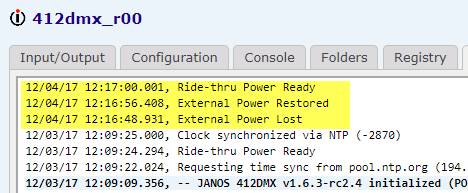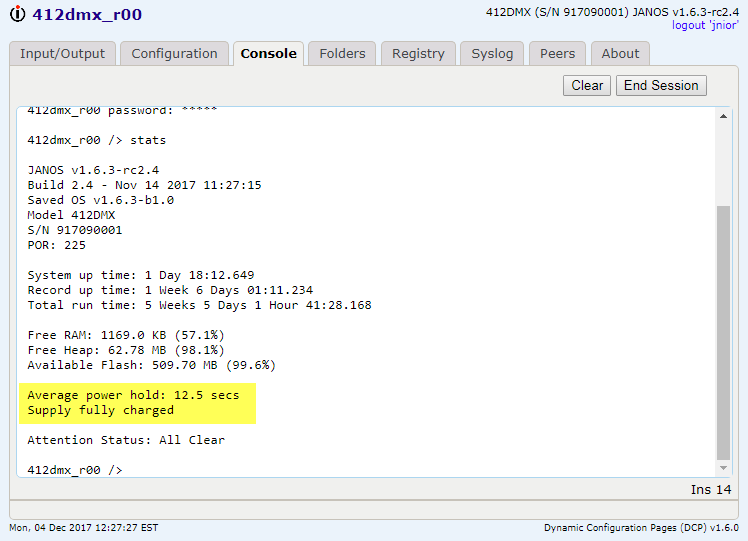One Advantage of the Ride-Thru Power Tech December 4, 2017
We’ve been experimenting with ride-thru power supplies. Basically the JNIOR continues to run after power is removed even though the unit is not battery powered. The hold time is relatively short and only a matter of seconds depending on the load on the supply at the time. But it is sufficient to weather short power outages and glitches that would otherwise cause the JNIOR to reboot. This ride-thru supply design makes sense for controller applications. It may save you the cost of a UPS if dirty power appears to be your issue. It will debut for INTEG in our 412DMX JNIOR.
One advantage of this is that we know when power has been removed or lost. We also know when it has been restored. That means we can now tell if the JNIOR has been left powered off and then booted up by looking at the log. With product without this technology you cannot tell from the log if there was a spontaneous reboot or what may have occurred.
This 412DMX prototype (the first) had been off for a couple of days and, well, it can’t hide that fact.

We see now that the unit was powered down for roughly 74 hours. When NTP re-synchronized the clock it had gotten 2.87 seconds fast. That is an error of about 1%. It goes to the importance of clock synchronization through NTP. If your JNIOR does not have access to the Internet and the host of NTP servers out there, maybe there is one on your internal network. If not perhaps there is another approach you can use to keep accurate time.
It is surprising that in this day and age that clocks in our computers are not much more precise. Some devices now get accurate time through the GPS system. Others over the cellular networks. Nether are generally available to a JNIOR. Don’t ask me about the RTC in the Renesas RX63N. I’ll go off on a rant!
So here is what you would see for a brief power outage. In this case the JNIOR never skipped a beat. There was no reboot and the DCP never had to reconnect.

Here power was out for some 7 to 8 seconds (I yanked the plug). Subsequently the ride-thru supply recharged itself so it would be ready to do it all over again.
Okay, not so impressive given that we are spoiled by all of our battery devices like phones, tablets and laptops. But there isn’t the cost of the battery nor the risk of fire. And, given that the JNIOR controller is generally powered 24/7 that extra hardware isn’t justified. But it does piss you of when the power company decides to reboot all of your unprotected equipment when the reconfigure the Grid. This handles that.
By the way, this R00 prototype has a 5F capacitor in which it stores the holding energy. The R01 prototype has 10F and that is likely what we will be shipping. You can see here using the STATS command that the average hold time for the 5F unit is about 12.5 seconds (no real load). The 10F units pushes 20 seconds.


